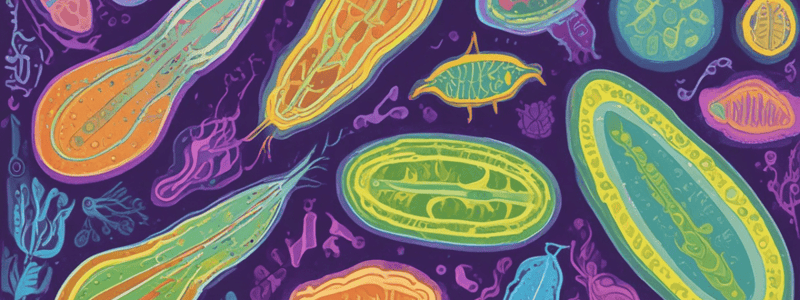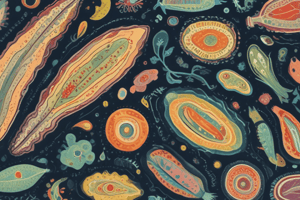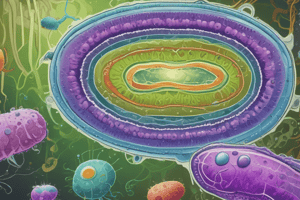Podcast
Questions and Answers
What is a characteristic that is unique to fungi?
What is a characteristic that is unique to fungi?
- Presence of chloroplasts
- Chitin-based cell walls (correct)
- Cellulose-based cell walls
- Ability to undergo photosynthesis
What is the role of mycorrhiza in fungi?
What is the role of mycorrhiza in fungi?
- Forming symbiotic relationships with plant roots (correct)
- Forming lichens with algae
- Decomposing organic matter
- Producing antibiotics
What is a characteristic that is shared between plants and algae?
What is a characteristic that is shared between plants and algae?
- Presence of chitin-based cell walls
- Ability to undergo photosynthesis
- Ability to form symbiotic relationships
- Multicellular and eukaryotic (correct)
What is the main difference between charophytes and plants?
What is the main difference between charophytes and plants?
What is the role of cuticle in plants?
What is the role of cuticle in plants?
What is the characteristic that distinguishes seed plants from non-seed plants?
What is the characteristic that distinguishes seed plants from non-seed plants?
What is the function of pollen in plant reproduction?
What is the function of pollen in plant reproduction?
What is the main difference between spores and seeds?
What is the main difference between spores and seeds?
What is the characteristic that distinguishes angiosperms from gymnosperms?
What is the characteristic that distinguishes angiosperms from gymnosperms?
What is the function of flowers in angiosperms?
What is the function of flowers in angiosperms?
What is the main function of the root system?
What is the main function of the root system?
What is unique about the stamen in angiosperms?
What is unique about the stamen in angiosperms?
What is the role of the ovary in angiosperms?
What is the role of the ovary in angiosperms?
What is the function of the xylem in plants?
What is the function of the xylem in plants?
What is the primary function of the dermal tissue?
What is the primary function of the dermal tissue?
What is the function of the vascular cambium?
What is the function of the vascular cambium?
What is the function of the sieve-tube elements in the phloem?
What is the function of the sieve-tube elements in the phloem?
What is the function of the stomata?
What is the function of the stomata?
What is the function of mycorrhizal fungi?
What is the function of mycorrhizal fungi?
What is the role of aquaporins in plant water transport?
What is the role of aquaporins in plant water transport?
What is the primary characteristic that defines protists?
What is the primary characteristic that defines protists?
Which of the following is NOT a mode of nutrition found in protists?
Which of the following is NOT a mode of nutrition found in protists?
Which group of protists includes the organisms Trypanosoma and Euglena?
Which group of protists includes the organisms Trypanosoma and Euglena?
What is the characteristic feature of Diatom cell walls?
What is the characteristic feature of Diatom cell walls?
Which protist causes malaria?
Which protist causes malaria?
What is the primary mode of locomotion used by Paramecium?
What is the primary mode of locomotion used by Paramecium?
What is the term for the relationship between two species in which one organism lives inside the cell or cells of the other?
What is the term for the relationship between two species in which one organism lives inside the cell or cells of the other?
Which group of protists is most closely related to plants?
Which group of protists is most closely related to plants?
What is the primary characteristic that distinguishes fungi from protists?
What is the primary characteristic that distinguishes fungi from protists?
Which of the following is an example of a unicellular fungus?
Which of the following is an example of a unicellular fungus?
What is the primary function of aquaporins in plant cells?
What is the primary function of aquaporins in plant cells?
Which of the following elements is a micronutrient required by plants?
Which of the following elements is a micronutrient required by plants?
What is the role of rhizobacteria in plant nutrition?
What is the role of rhizobacteria in plant nutrition?
What is the primary function of mycorrhizae in early land plants?
What is the primary function of mycorrhizae in early land plants?
What is the primary function of petals in a flower?
What is the primary function of petals in a flower?
During double fertilization, what is the outcome of the fusion of the second sperm with the two polar nuclei?
During double fertilization, what is the outcome of the fusion of the second sperm with the two polar nuclei?
What is the primary benefit of asexual reproduction in plants?
What is the primary benefit of asexual reproduction in plants?
What is a potential risk associated with genetically modified plants?
What is a potential risk associated with genetically modified plants?
What is the primary function of nitrifying bacteria in soil?
What is the primary function of nitrifying bacteria in soil?
What is the primary function of fruits in plants?
What is the primary function of fruits in plants?
What is the characteristic that distinguishes Euglena from other protists?
What is the characteristic that distinguishes Euglena from other protists?
Which group of protists is characterized by the presence of cilia?
Which group of protists is characterized by the presence of cilia?
What is the common characteristic of Brown algae and Dinoflagellates?
What is the common characteristic of Brown algae and Dinoflagellates?
Which protist is responsible for causing sleeping sickness in humans?
Which protist is responsible for causing sleeping sickness in humans?
What is the characteristic feature of Amoeba?
What is the characteristic feature of Amoeba?
Which group of protists includes organisms that have a unique glass-like wall of silicon dioxide?
Which group of protists includes organisms that have a unique glass-like wall of silicon dioxide?
Which protist is characterized by the presence of pseudopodia?
Which protist is characterized by the presence of pseudopodia?
Which group of protists includes organisms that are mixotrophs?
Which group of protists includes organisms that are mixotrophs?
Which protist is responsible for causing malaria?
Which protist is responsible for causing malaria?
Which group of protists is characterized by the presence of slime molds?
Which group of protists is characterized by the presence of slime molds?
Flashcards are hidden until you start studying
Study Notes
Protists
- An informal term for eukaryotes that are not plants, animals, or fungi
- Characteristics:
- Have a nucleus and membrane-enclosed organelles
- Most are unicellular, but some are multicellular
- Nutritionally diverse (photoautotrophs, heterotrophs, mixotrophs)
- Endosymbiosis: a relationship between two species where one organism lives inside the cell or cells of the other
- 4 groups:
- Excavata (Trypanosoma, Euglena)
- SAR (Diatoms, brown algae, water molds, Dinoflagellates, Plasmodium, Paramecium)
- Archaeplastida (red and green algae, Charophytes, Volvox)
- Unikonta (Amoeba, slime mold)
Fungi
- Heterotrophs that absorb nutrients from outside their bodies
- Characteristics:
- Mostly multicellular, but some are unicellular (e.g., yeast)
- Cell walls made of chitin
- Sexual and asexual reproduction
- Body structure:
- Hyphae: tubular cell walls strengthened with chitin, divided into cells by septa
- Mycelium: an interwoven mass formed by hyphae, maximizing surface area for absorption
- Roles:
- Decomposers
- Mutualists
- Pathogens (e.g., ringworm, yeast infection)
- Medicine (e.g., penicillin)
Mutualism of Fungi
- Mycorrhiza: mutually beneficial relationships between fungi and plant roots
- Lichen: symbiotic associations between photosynthetic microorganisms and fungi
- Fungus-farming ants: some fungi share digestive services with animals
Plant Diversity
- Role of plants: oxygen production, food sources, habitat for land organisms
- Similarities between plants and green algae:
- Multicellular, eukaryotic, photosynthetic autotrophs
- Cellulose cell walls
- Chloroplasts
- Differences:
- Alternation of generations
- Walled spores produced in sporangia
- Apical meristems
- Cuticle and stomata unique to plants
Evolution of Plants
- From cyanobacteria to green algae to land plants
- Four groups of plants:
- Nonvascular plants (Bryophytes, Mosses)
- Seedless vascular plants (ferns)
- Gymnosperms (naked seeds)
- Angiosperms (flowers, double fertilization, nearly 90% of living plants)
Seed Plants
- Sporophyte-dominated life cycle
- Characteristics:
- Reduced gametophytes
- Heterospory
- Ovules
- Pollen
- Pollination: transfer of pollen to ovules
- Seeds:
- Consist of embryo and nutrients surrounded by a coat
- Can remain dormant for years
- Can be transported long distances by wind or animals
- Gymnosperms:
- Naked seeds exposed on sporophylls (e.g., conifers)
- Angiosperms:
- Seed plants with reproductive structures called flowers and fruits
- 90% of all plants
Plant Structure
- Hierarchical organization: cell – tissue – organ – organism
- Plant organs:
- Roots (root system)
- Stems and leaves (shoot system)
- Root functions:
- Anchoring the plant
- Absorbing minerals and water
- Storing carbohydrates
- Stem functions:
- Elongating and orienting the shoot
- Maximizing photosynthesis
- Leaf functions:
- Main photosynthetic organ
- Exchanging gases
- Defending against herbivores and pathogens
Plant Tissues
- Dermal tissue: protective outer coating
- Vascular tissue: facilitates transport of materials and provides mechanical support
- Ground tissue: specialized cells for storage, photosynthesis, and support
- Meristem tissue: for growth and development
Plant Cells
- Parenchyma: performs most metabolic functions
- Collenchyma: provides flexible support
- Sclerenchyma: rigid cells with secondary cell walls containing lignin
- Water-conducting cells of the xylem: tracheids, vessel elements
- Sugar-conducting cells of the phloem: sieve-tube elements, companion cells
Resource Acquisition and Transport
- Xylem: transports water and minerals from roots to shoots
- Phloem: transports photosynthetic products from where they are made to where they are needed
- Stomata: pores necessary for CO2 diffusion into photosynthetic tissues
- Mycorrhizae: fungal associations increase surface area for absorbing water and minerals
- Aquaporins: transport proteins facilitating water passage across cell membranes
Soil and Plant Nutrition
- Essential elements: 17 chemical elements required for plant life cycle
- 9 macronutrients: required in large amounts
- 8 micronutrients: required in small amounts
- Plant mutualism with soil bacteria: rhizobacteria and endophyte
- Nitrogen fixation: required for plants to acquire nitrogen as nitrate
Angiosperm Reproduction
- Angiosperm anatomy:
- Flowers: reproductive shoots of the angiosperm sporophyte
- Four parts of flowers: carpels, stamens, petals, sepals
- Angiosperm life cycle:
- Gametophyte development
- Sperm delivery by pollen tubes
- Double fertilization
- Seed development
- Pollination: transfer of pollen from anthers to stigma
- Double fertilization: fusion of gametes
- Fruits: mature ovary of a flower, protects seeds and aids in seed dispersal
Eukaryotic Groups
- Excavata group consists of Trypanosoma and Euglena
- Trypanosoma infects humans, causing sleeping sickness
- Euglena has one or two flagella and is mixotrophic
SAR Group
- Diatoms are unicellular algae with a unique glass-like wall of silicon dioxide
- Brown algae are the largest and most complex multicellular algae, with some being edible seaweeds
- Dinoflagellates are marine and freshwater phytoplankton with two flagella, often causing toxic red tides
- Plasmodium is a parasite that causes malaria
- Paramecium uses cilia to move around and feed on bacteria or other protists
Archaeplastida Group
- Charophytes are a type of green algae, most closely related to plants
Unikonta Group
- Amoeba has pseudopodia
- Slime mold resembles fungi due to convergent evolution
Eukaryotic Groups
- Eukaryotes are divided into four groups: Excavata, SAR, Archaeplastida, and Unikonta.
Excavata
- Includes Trypanosoma and Euglena.
- Trypanosoma infects humans, causing sleeping sickness.
- Euglena have one or two flagella and are mixotrophs.
SAR (Stramenopila, Alveolata, and Rhizaria)
- Includes Diatoms, brown algae, water molds, Dinoflagellates, Plasmodium, and Paramecium.
- Diatoms are unicellular algae with a unique glass-like wall of silicon dioxide.
- Brown algae are the largest and most complex multicellular algae, with some species being edible seaweeds.
- Dinoflagellates are marine and freshwater phytoplankton, characterized by two flagella, and often cause toxic red tides.
- Plasmodium is a parasite that causes malaria.
- Paramecium use cilia to move around and feed on bacteria or other protists.
Archaeplastida
- Includes red and green algae, as well as Charophytes.
- Charophytes are a type of green algae, most closely related to plants.
Unikonta
- Includes Amoeba and slime mold.
- Amoeba have pseudopodia.
- Slime mold resembles fungi due to convergent evolution.
Studying That Suits You
Use AI to generate personalized quizzes and flashcards to suit your learning preferences.




